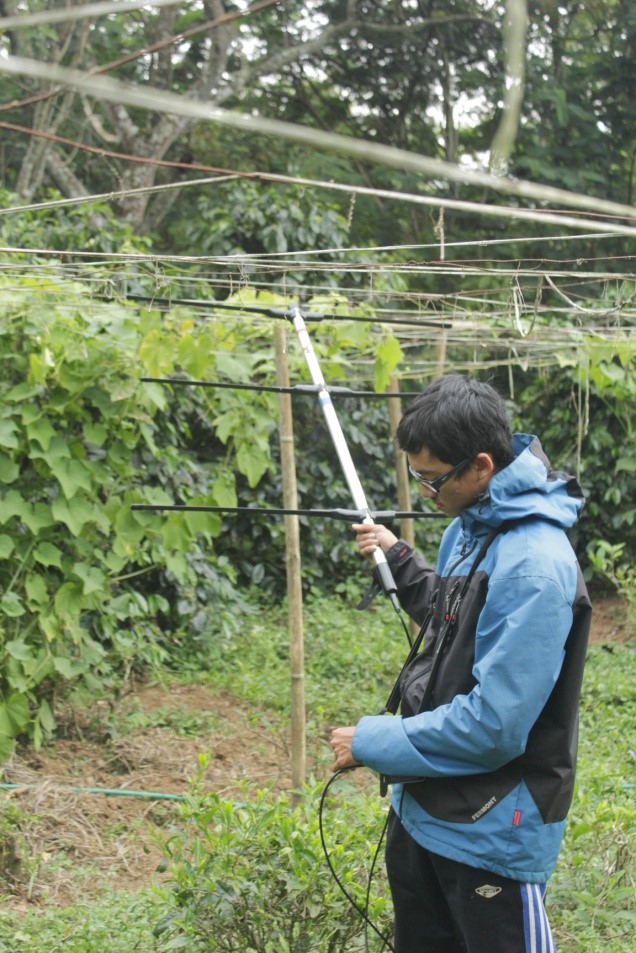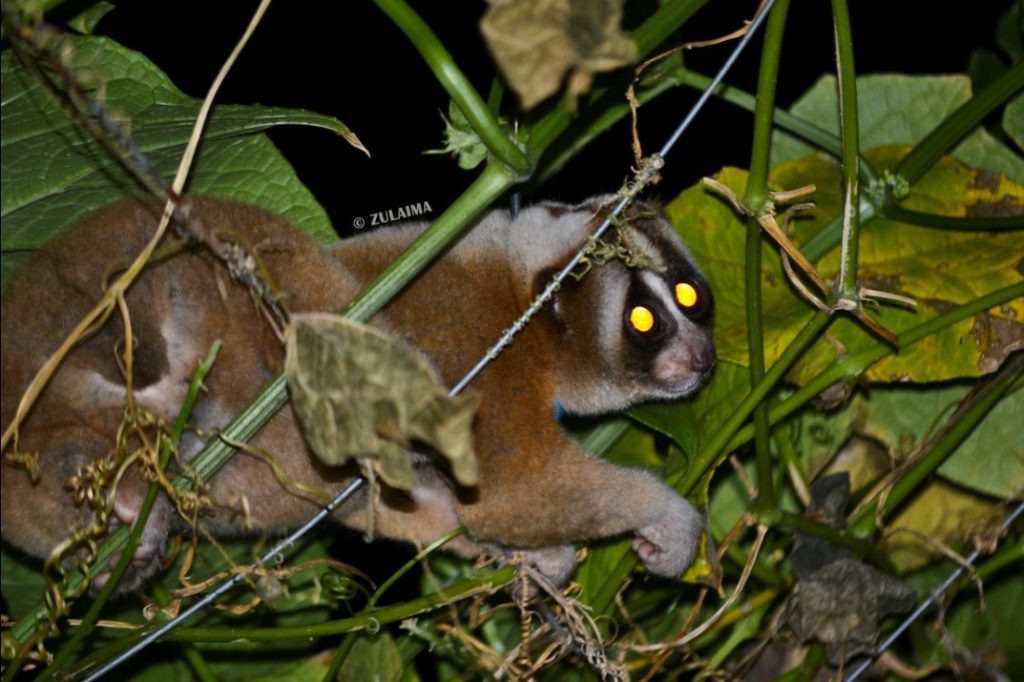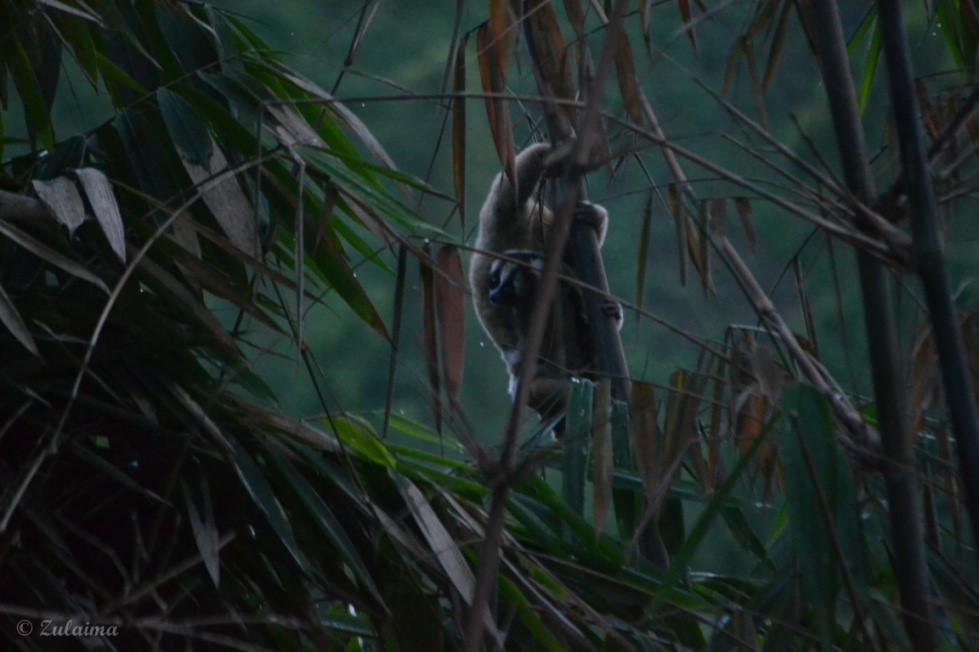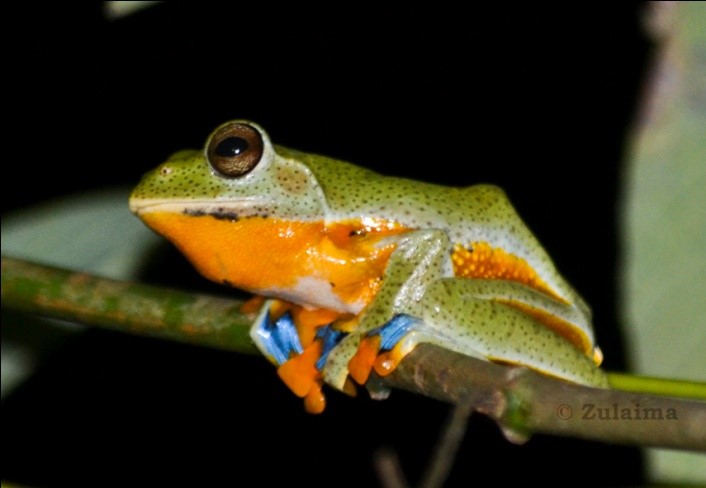Hi there, I am Zulaima Rakhmatiar. but my friends just call me Aim. I’m from Yogyakarta, Indonesia and I study at the faculty of Forestry at Universitas Gadjah Mada Yogyakarta. My studies focus on wildlife, especially birds. I am currently a volunteer at LFP and I have a project about interactions between Javan Slow Loris (Nycticebus javanicus) with birds. This is my primary research for my undergraduate thesis. In Cipaganti, Garut there is a lot of farm and agroforestry. In Sundanese (the native language of West Java) agroforestry is called “Talun”. The Javan Slow Loris currently must live in this changed habitat. Farmers plant many vegetables like cabbages, pumpkins (in Indonesian called Labu Siam), tomatoes, eggplants, potatoes etc. In Cipaganti there are a lot of tea gardens too. At the edge of the gardens there are certain tree species including: Kayu Putih (Eucalyptus sp.), Suren (Toona sureni), Avocado (Persea americana), Kayu Angin (Casuarina junghuniana), Bamboo and more.
Talun on Cipaganti as a habitat for Javan Slow Loris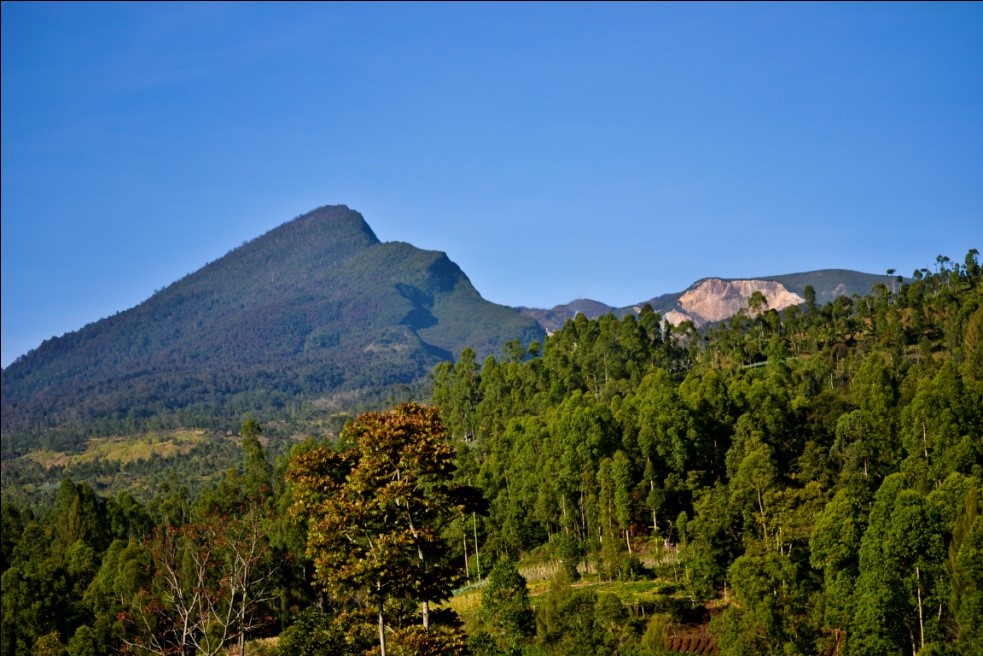
Javan Slow Lorises are the one of threatened primates in the world. The Javan Slow Loris is endemic, so they can only found in Java, Indonesia. The IUCN Redlist states the Javan Slow Loris status as Critically Endangered since 2013. This is my first time I have studied lorises and been able to observe them. It’s very interesting because I can see directly this rare animal and how it still manages to exist even in fragments of their natural habitat. At LFP, there are several activities surrounding the Javan Slow Loris focused on their conservation. These activities include: observation and monitoring, camera traps, rounds, photo shifts, captures, and sleeping sites. Observation – We can see and record the behavior of loris from when it wakes up until they go to sleep. On observation there are 2 shifts. Shift one is from 5pm until 11pm and shift two is from 11pm until 5am. Camera traps – We can check out the camera trap condition in the field and keep the data record to analyze for many different species including the Javan Slow Loris. Rounds are for recording the behavior for each of our collared lorises for 15 minutes. Photo shifts are to photograph the activity of the animals in the area. Capture is only to catch the lorises if necessary either to check their condition or the condition of radio collar, but other data (morphological) can also be collected. There are 18 lorises which have radio collars here. The radio collar is very important, because it easily allows us to observe and monitor each individual loris. In order to find the loris we can find the signal by entering the frequency number on receiver and adjust the antenna in any direction. If the receiver beep is louder and the signal power is high that means the loris is near. Sleeping site shifts record where are the lorises are sleeping. This activity takes place in the day when the lorises are asleep. Generally, the Javan Slow Loris in Cipaganti sleep in bamboo. There are 4 kinds of bamboo here, in the local language they are called Bambu Temen, Bambu Surat, Bambu Tali, and Bambu Besar.
At LFP there are also activities about educating villagers and encouraging them to protect the lorises habitat to save the species. This is very important so that the lorises can still exist and thrive in the future. Market Survey is an important activity. This is where we go to animal and pet markets to see and record what kind animal are being sold. Animal markets in Indonesia are still traditional – in general, people are selling and buying mainly birds. The vendor sells both wild and captive bred birds. When I went on Market Survey, I saw many kind of birds being sold. I saw rare birds and protected birds. All eagles (Accipitridae and Falconidae) in Indonesia are protected by law and cannot be sold, however I saw an eagle for sale. It was still a chick and it was a Black Eagle (Ictinaetus malayensis). It was really sad to see. Some of the rare birds in Java include: the Javan Banded Pitta (Pitta guajana), the Sunda Coucal (Centropus nigrorufus) and the Chesnut-bellied Partridge (Arborophila javanica). I believe that these rare birds have caught because of poaching in order to sell. That’s the actual condition in Java – still selling the rare, threatened, and protected birds. Hopefully in the future the illegal pet trade will cease and the birds can exist happily in their habitat and flourish.
My project focuses on interactions between the Javan Slow Loris and birds. I go to field at 4am because as nocturnal animals, lorises start to sleep around that time. Therefore I can observe the lorises preparing for sleep and note the sleeping position at the sleeping site. Usually the lorises sleep in bamboo. I have been following three lorises: Toyib, Shirley, and Bintang. At 4am birds start to become active and I can see and identify which species of bird are in the area as well as in the sleeping site. I observe the loris and the birds all day (12 hour shift). This allows me to see the lorises sleep and sometimes if they show activity during the day. However, when the lorises sleep in bamboo it can be very difficult to see them as the leaf density is very high and many branches cover the loris. Once when I followed Toyib, he was active during the day at about 11:35am! Toyib climbed down from his sleep position, hanging onto the bamboo and doing a little bit of grooming. After that, he back to recent sleeping position. That was wonderful because I can see nocturnal animal being active during the day.
Toyib active at day and Toyib sleep in bamboo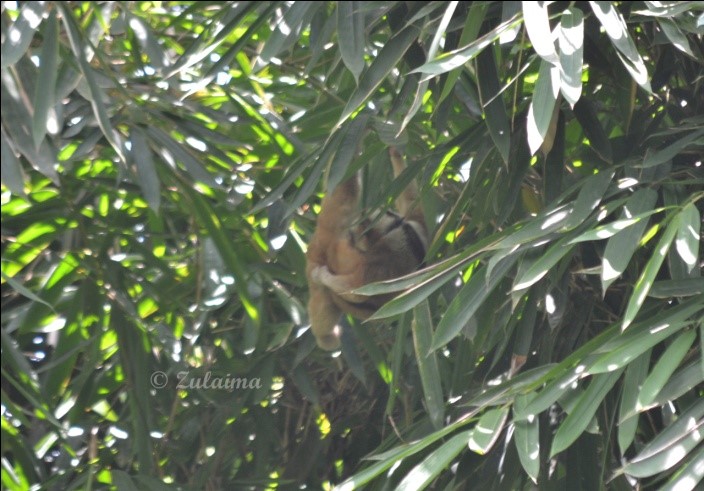
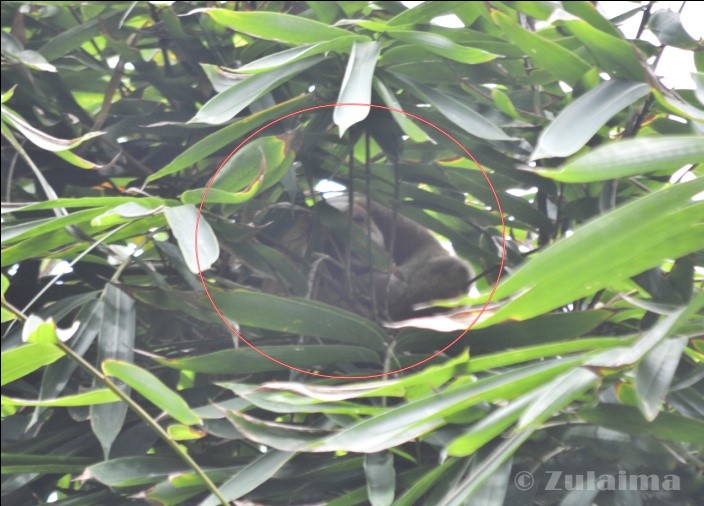
Once when I followed Shirley, I saw she was carrying her baby and walking towards bamboo. Shirley was preparing to sleep with her baby. She climbed into some bamboo, searching for a comfortable and safe place to sleep. She decided to sleep in the bamboo canopy (very high density). I was very happy to observe the social and parental care of the lorises. It is amazing to see that a critically endangered species still has the opportunity for a next generation despite the habitat loss. Successful offspring will hopefully help to sustain and eventually stabilize the population.
When I was following Bintang, I saw her eating gum on a Jiengjen tree at about 07:15am. This was my first time I directly saw a nocturnal animal eating during the day. It was a wonderful experience. Bintang also sleeps later than other lorises. In general, the Javan Slow Loris start to sleep between 4 and 5am. However, with Bintang, I have seen her sleep as late as 6:15am. She also has unusual sleeping sites and doesn’t seem to sleep in bamboo.
Bintang eat Jiengjen tree gum at day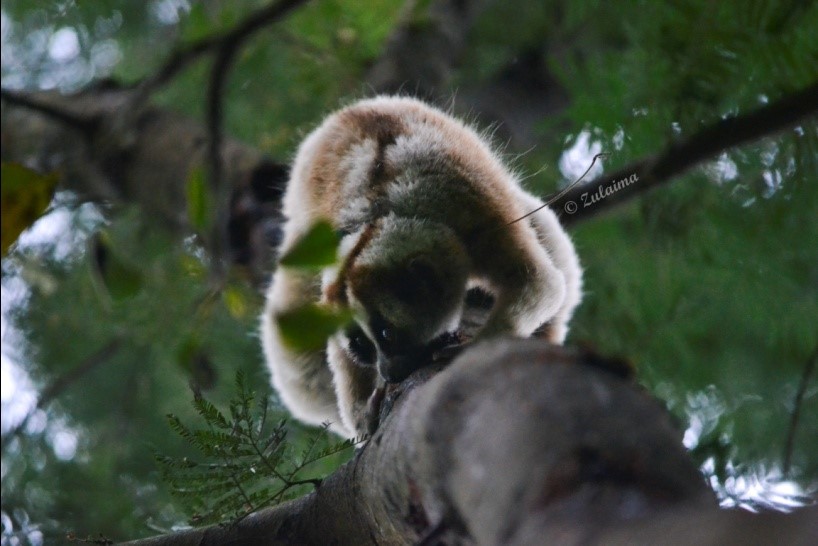
Sometimes birds perch on the sleeping tree branches, but it is very rare that birds interact with lorises. Sometimes there was an eagle flying very close to the loris sleeping site with the loris’s position in the bamboo canopy at edge of the bamboo patch. Despite this there was no activity or response from the lorises. Besides eagles, there are many other species of birds including: Javan Kingfishers (Halcyon cyanoventris), Olive-backed Tailorbirds (Orthotomus sepium), Ashy Tailorbirds (Orthotomus ruficeps), Sooty-headed Bulbuls (Pycnonotus aurigaster), Long-tailed Shrikes (Lanius schach), Crescent-chested Babblers (Stachyris melanothorax) and Olive-backed Sunbirds (Nectarinia jugularis). These birds are species that I have recorded activity of at loris sleep sites. One time, I saw a migrant bird, it was the Asian Brown Flycatcher (Muscicapa dauurica). During the native winter season, they move to warm areas like Indonesia. That individual was perching and foraging in Bintang’s sleeping tree (Avocado tree), however the bird was far away from Bintang and therefore there was no interaction between them. It was interesting to see that despite the agroforestry in Cipaganti that it can still be successfully used as a migration destination for certain bird species.
Asian Brown Flycathcer (Muscicapa dauurica)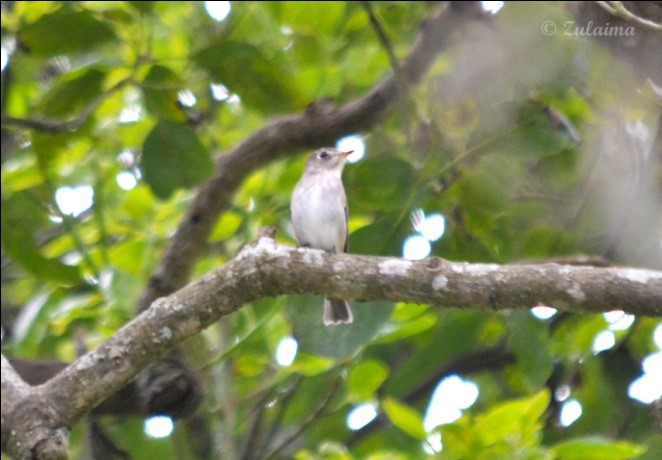
Crescent-chested Babbler (Stachyris melanothorax)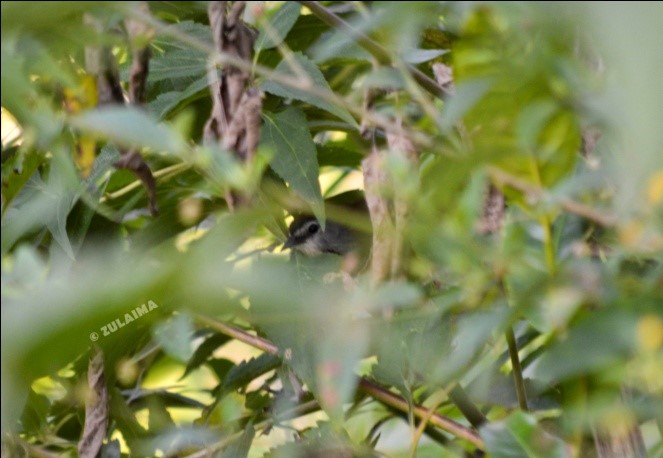
In the area of Cipaganti where the lorises home ranges lie, there are 4 species of diurnal raptor birds I can record. There are the Javan Hawk Eagle (Nisaetus bartelsi), Changeable Hawk Eagle (Nisaetus cirrhatus), Crested Serpent Eagle (Spilornis cheela), and Black Eagle (Ictinaetus malayensis). There is also a nocturnal raptor, the Sunda Scops Owl (Otus lempiji). The raptor birds can be a predator for lorises, particularly for loris babies. During my time at LFP I have found other interesting animals such as Rhacophorus reinwardtii – a beautiful frog. Cipaganti is a interesting, beautiful and exciting place and I have gained so much experience about wildlife and conservation with LFP. I hope you enjoyed reading about my time here!
Javan Hawk Eagle (Nisaetus bartelsi)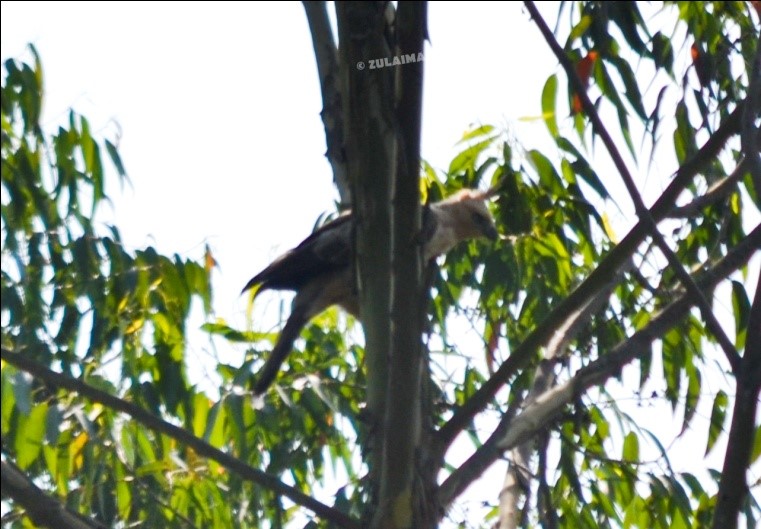
Black Eagle (Ictinaetus malayensis)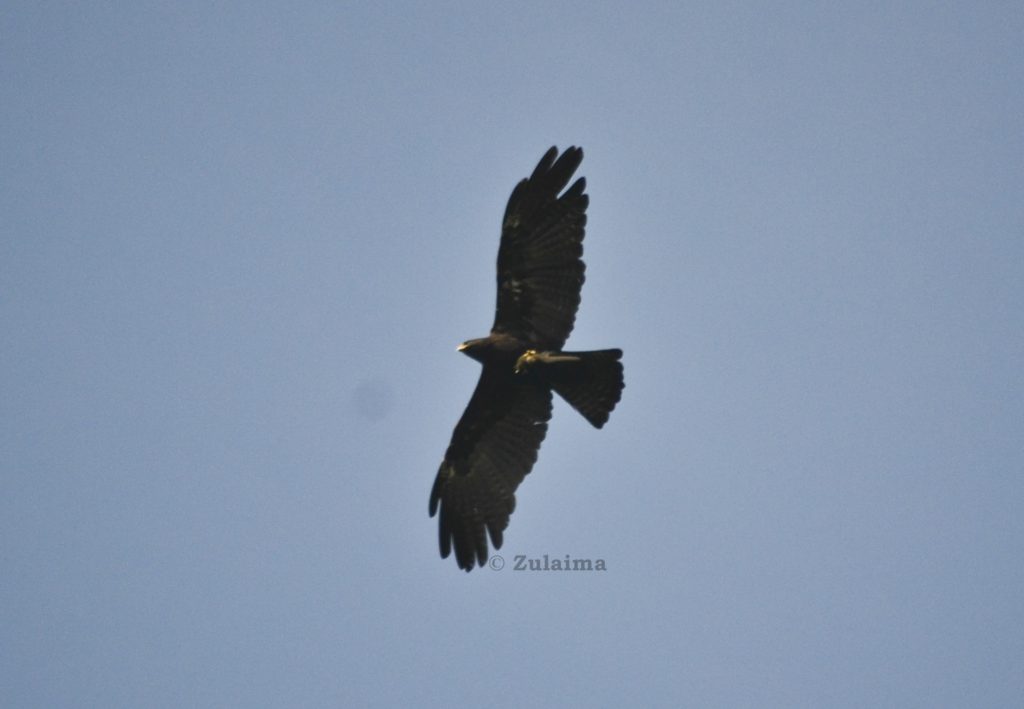
(all photos are my own)


